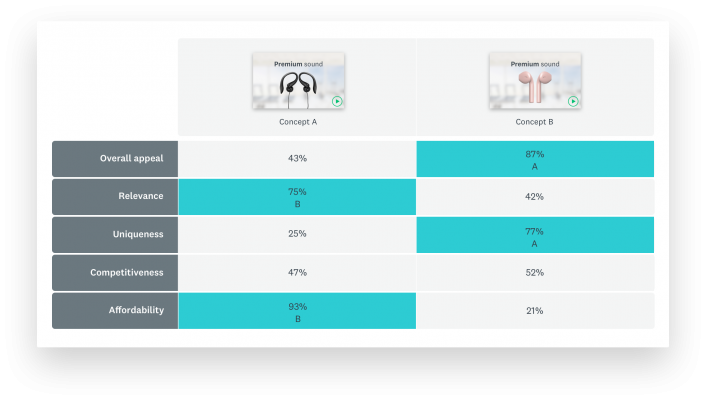More Resources
When developing a user persona, your goal is to describe your ideal customer. Who are they? What problems do they have? You use these descriptions to understand who will buy your products and services.
You can start by performing user research about actual users of your products, to represent your target audience. You can also use surveys to research consumers as a whole.
Demographics (like age, location, and gender), psychographics (like personality traits or interests), technographics (segments based on technology used), and other traits are valuable inputs to your user persona development. Surveys, customer data, purchase transactions and other data will provide meaningful quantitative data about your users.
However, a user persona isn’t just a group of statistics. User personas, buyer personas and customer personas all need descriptive data that helps you empathize with them as real people. That’s why it is important to add names, stock photos, and lifestyle descriptions that bring each persona to life.
User personas were first developed in the 1980’s by Alan Cooper, a computer software programmer and author, to help him keep his user in mind as he wrote a project management program.
Alan performed his user research by talking to a woman named “Kathy” at an advertising agency. While playing golf, Alan would role-play discussions with “Kathy”, about what she needed from his software program to have a great user experience.
User personas are used commonly by software developers, design engineers, marketing and advertising professionals.
User personas should:
- Represent a major group of users
- Describe real people, including their goals and backgrounds
- Describe and focus on the major needs and expectations of your most important user groups
- Give a clear expectation of how the user will use your product
- Help uncover universal features and functionality.
Marketing and advertising companies now create user personas to describe their customers and buyers. By performing market research surveys, they discover who their ideal customers are and create vivid descriptions about their behaviors and motivations.
Identify your ideal users
Target your market with SurveyMonkey's Audience panel and find where your ideal customers are.
When do you need user personas?
User personas help you create an archetype of people who will buy your products and services. It describes real life behaviors, needs, values, concerns, pain points, and challenges.
When are they most useful for marketing to your customers? It starts by understanding who your ideal customers are.
Customer segmentation divides large groups of people into small groups with common traits. For instance, there are millions of people who drink tea, but which people would most likely buy your new caffeine-free green tea?
Surveys help you collect demographics, psychographics, and lifestyle information to identify customer segments of people who buy products and services. By conducting a survey, you will better understand many customer segments and what their tea drinking habits are.
Once you define customer segments, you will develop buyer personas like Lily the Yoga Lover, Herbert the Herbalist, and Cate the Commuter. Each of these personas will have reasons why they drink tea, and your descriptions will bring them to life.
Target marketing is the practice of focusing on a single customer segment that is mostly likely to buy your product or service. Based on the buyer personas you developed by segmenting customers, you will choose a few persons that have the highest possibility of buying your new tea.
Audience targeting surveys will uncover more information about your persona’s buying habits and motivations. You can also gather data of both domestic and international respondents to give you a global perspective.
Concept testing is a great way to test your new ideas with your target audience. Concept testing surveys let you test specific ideas with your target audience. Before launching a new brand of tea, your audience will let you know their ideas about your product idea, pricing, flavors, and product name.
Over 30,000 new consumer products are launched each year. Concept testing with your buyer personas lowers your risk of going to market with an untested idea and a product that no one will buy.
Package, logo, and website design can also be tested with your ideal audience. Buyer personas are frequently used in the design process to see if it attracts the eye of the customers. Surveys can help you quickly understand if your packaging, logo, or website will be used by your ideal customer.

The benefits of user personas
The primary benefit of user personas is that they help you to quickly understand your target audience’s needs. People find it easier to sell to other people when they can describe and empathize with them.
Developing a buyer persona is based on both qualitative and quantitative research to help you create an objective description of your buyer. Without this objectivity, buyer personas can become biased and just a reflection of the marketer writing the persona.
Surveys are beneficial because they collect objective data from your ideal customer segment about their habits, motivations, demographics, and more. Since the data comes directly from the audience, it greatly reduces the chance for bias.
Buyer personas make the marketing, advertising, and selling processes more efficient. Because you understand the needs of your target buyer in advance, it is easier to create a marketing mix of product, price, promotion, and placement that appeals to them.
User personas serve a valuable purpose in both B2C and B2B marketing. In B2C marketing, personas represent an individual’s wants, needs, and concerns. In B2B marketing, the buyer persona can be more complex.
For B2B marketing, you must consider the company’s demographics, the buyer’s demographics and position in the company, and what their motivations are for buying. The benefit of the B2B buyer’s persona is that it makes marketing and selling more efficient, but it requires more data. The benefits of B2B buyer personas include educating your company on who your target audience is and efficiently use your marketing budget.
Since the buyer’s journey is longer in the B2B world, you can create multiple personas who interact at every part of the way including users, purchasing departments, and financial decision makers.
No matter if your target audience are consumers or corporate users, buyer personas help you understand and solve the challenges they face. Surveys are a quick and efficient way to identify and reach your target market and understand their perceptions and behaviors.
Take the guesswork out of customer mapping. SurveyMonkey's Audience panel makes marketing more efficient.

How to create good user personas
While buyer personas are a great tool, people often ask how to make a persona. The first step is research. You can’t assume who your customers are or you will be one of the 95% of new products that fail each year. Using best practices will make your user personas more effective.
Step 1 - Conduct user research
First, you should define your project goal. Are you selling a new product, testing a concept, or just trying to define your audience? A clear purpose will guide your research and the methodology you use to collect data.
Market research surveys are a great tool to understand the demographics, psychographics, and behavior patterns of different customer segments. Other market research resources can help you take a closer look at what concepts they like and are willing to buy. Interviews, observations, and customer comments will also add to your research.
Step 2 - Analyze your data
Based on your research, you will find many customer attributes, but only some of these people will want to buy from you. Depending on your project needs, narrow down your groups to 3 to 4 because too many groups are too confusing or too detailed for practical use.
Research and insights are the key to an accurate persona. SurveyMonkey's Audience panel can help you discover your ideal audience—below are just a few of the groups we survey.

General Population (Medium Sample)
- All Genders (Census)
- All Ages (Full Census)
- All Incomes
- 500 Responses, United States (USA) - SurveyMonkey

Full-Time Employees
- All Genders (Census)
- All Ages (Basic Census)
- All Incomes
- Employed Full-time
- 250 Responses, United States (USA) - SurveyMonkey

Consumer Shoppers
- All Genders (Census)
- All Ages (Basic Census)
- All Incomes
- Primary Decision Maker in Household
- 250 Responses, United States (USA) - SurveyMonkey
Step 3 - Write personas that reflect real life
Now is the time to brainstorm with your team and come up with names, key demographics, stock pictures, and challenges that each persona has. Your combination of research and creativity will bring each of your personas to life.
Remember to focus on creating personas that most closely reflect your ideal customer and your project goals. Include elements that not only describe your audience, but help you to understand and empathize with them. They should be concise, relevant, and easy to remember.
Personas provide a quick yet detailed way to understand your B2C or B2B customer. You can also take them to the next level by following them through the every step of a buyer’s journey to add more information about their persona.
Elements of a persona
As you write your personas, you will add detail that describes who they are, their behaviors, and motivations. Below are the elements you should include in your buyer persona.
Write a descriptive header
Your header should include a descriptive name and stock photograph that represents your persona. A short descriptive quote is also helpful. Remember, your goal is to create a name and image that your team will remember and will reflect the needs of a larger customer group.
For instance, let’s say you are marketing a new type of hand cream that will soften even the roughest of hands. Your research showed that people who work a lot with their hands, including gardeners, mechanics, and farmers all have problems with rough, dry skin. You can develop several personas for each of these customer groups.
As an example, “Greta the Gardner. “I’ve been gardening for 25 years, and my hands show it,” is one persona you could develop.
Describe your persona
Now is the time to summarize the personal and professional characteristics of your persona. For Greta the Gardener, you might write her detailed description.
Personal: Age 52, middle income, married with two teenage children, works full time, lives in the suburbs, gardens for pleasure, prefers to shop in stores but also orders online. Likes to save money while still looking her best.
Professional: Greta works as an accountant in an office environment and interacts with co-workers, bosses, and clients. She still has to look professional and uses her hands a lot while working on a computer..
These personal and professional characteristics help you better understand Greta and what her lifestyle is like on a daily basis.
Challenges
Based on your customer persona’s personal and professional characteristics, you will want to understand what problems the persona has each day.
For Greta the Gardener, we know that she works a lot with her hands, both professionally and in her hobby as an avid gardener. She is price conscious, but still wants a product that is effective, sold in stores, and online.
Your solution
You will want to describe how your product solves the problems of the individual persona you described above.
For Greta the Gardener, your new product moisturizes rough, dry hands, without a pungent smell that co-workers might notice. It is also available in most retail stores and pharmacies in suburban locations and online. Your moisturizer is competitively priced and affordable, while proven effective for rough hands that work all day.
Describe a day in the life with your product
In this section, you will show how your product meets the goals of your persona through a day-in-the-life description. How and where do you envision that this persona uses your product? Is it convenient and easy to use, or does it create any additional challenges?
For Greta the Gardener, the new moisturizer comes in a small bottle, where she can carry it in her purse so she can use it at work and at home. After a long day of gardening, Greta can wash her hands, apply the moisturizer and not feel oily or sticky as she goes about her day. Because it is convenient and doesn’t smell, her coworkers never know she uses it. Her hands look better and she is able to perform her work and favorite hobby.
As you develop these five elements, you will find it easier to create more user persona examples that meet your project goals. Putting them in a graphical display or book will also help your team remember and use your personas when developing products, concepts, messaging, and more.
User persona examples
Your buyer persona descriptions can be as long or as short as you wish. Remember, they are a reference point for your team to use in marketing activities, so use the length that works for you.
The detailed B2B persona
The Buyer Persona Institute provides a detailed persona of Stan, the General Manager at a construction company. This persona would be a great example of a persona for a heavy equipment manufacturer. The personal details include:
- Demographics - Picture, age, educational background, professional responsibilities and priorities
- Priorities - Motivations for buying heavy industrial equipment
- Success Factors - What benefits the company will receive if he buys the right equipment
- Perceived Barriers - What might keep him from accomplishing his goal
- Decision Criteria -What factors and motivations influence his buying decisions
- Buyer's Journey - What steps and decisions he has to make at every step of the buying process
B2C Food Delivery for Millennials
“Millennial Molly” is the example by Cyberclick and the Product Marketing Alliance to describe the buyer of healthy food kits. Molly’s persona included:
- Demographics - Age, location, profession
- Psychographics - Hobbies and interests
- Technographics - How Molly researches companies for alternatives
- Goals and Objectives - To eat healthy
- Pain Points - Doesn’t have much time
After describing these factors on one page, the company provides their solution.
“Millennial Molly is looking for a way to eat more fresh food, but lacks the time to plan meals herself. As a fresh meal kit delivery service, we can provide Molly with fresth, health, and pre planned meals so that she doesn’t have to spend her time on planning anymore. Every week, she can choose the meals she wants to receive, send her the ingredients and recipes, and schedule the deliveries.”
Working Mom Wendy B2C
Keeping your persona to one page can also help you describe your persona. Smartbug Media described “Working Mom Wendy” as she searched for childcare. Her persona included:
- Key identifiers - Full-time career, family-first values, educated, seeks healthcare information online, and does her research
- Background - A one line description of her demographics that include, “balancing her career and raising a family...she’s on the go...” bringing life to her character.
- Goals and Challenges - Stay healthy for herself and her kids while managing a busy schedule
- How we help - The solution provided by the healthcare company
Your buyer personas are only limited by your creativity. They can include detailed research or long descriptions of what motivates your buyer. Remember that your goal is to reflect your target audience and improve your ability to sell to them.
User persona tips for your target audience
Tip #1 - Use valid research
Collecting lots of data increases the validity of your research findings and provides proof of your conclusions. Market research templates and buyer persona surveys will help you create a database of information you trust.
Tip #2 - Refresh your personas
Personas are not a once-and-done project. They will change over time and reflect your buyer’s motivations. Update your personas by performing surveys, research, and observations to get the most current representation of your ideal customer.
Keep your personas up to date with SurveyMonkey's Audience panel.
Tip #3 - Remain objective
It is easy to create a buyer persona based on who you think your buyer is. Subjective personas increase the risk of creating a product that doesn’t sell or messaging that misses the mark. Stay objective when reviewing your data and be open to findings that challenge your opinions.
Tip #4 - Create quality personas
Your surveys will point to many different customer groups, but not all of them will buy from you. Focus on the personas, usually 3 or 4, that most closely reflect your target audience.
Tip #5 - Less is more
Long persona descriptions may be appropriate for some audiences, like B2B customers with a complex buyer’s journey. Most buyer personas can be written in 1-2 pages and provide an overview of who the buyer is and their motivations.
Using SurveyMonkey to help develop your personas
Use SurveyMonkey to research and create your buyer personas. We have access to a large audience of pre-qualified people who can answer your most important questions. Our survey templates are a cost-effective way to get speed-to-market insights for your next project.
Get started with your market research
Global survey panel
Collect market research data by sending your survey to a representative sample
Research services
Get help with your market research project by working with our expert research team
Expert solutions
Test creative or product concepts using an automated approach to analysis and reporting
